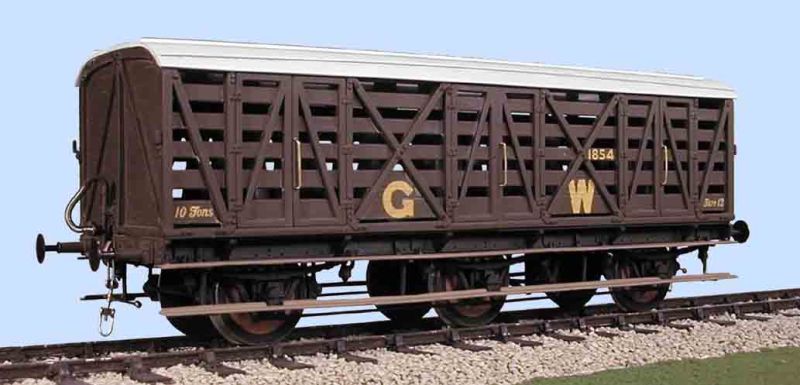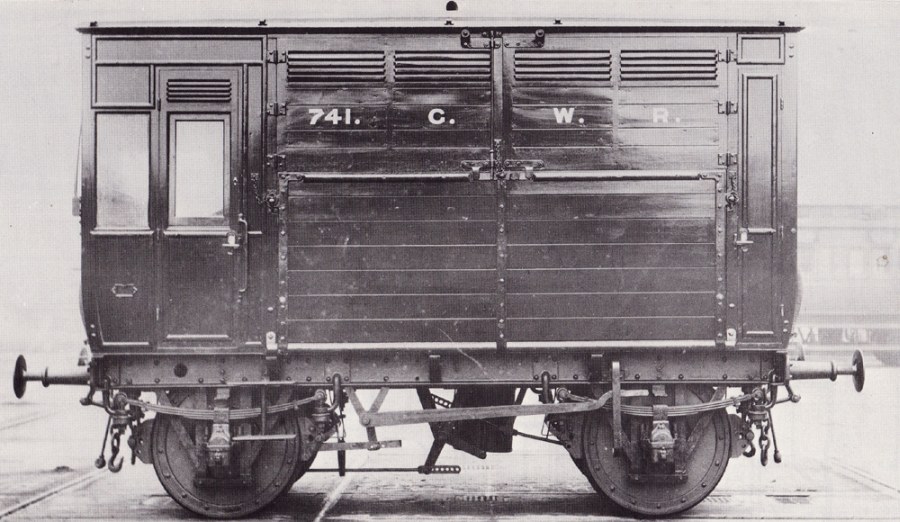| Section Page | Previous Page | Next Page |
GWR non-passenger-carrying coaching stock
|
| Nick Hunt's diagram N4 horse box built from a 7mm D&S kit. The photo is intentionally lightened to show detail – the colours on the actual model are darker. Details of the build can be found on RMweb. |
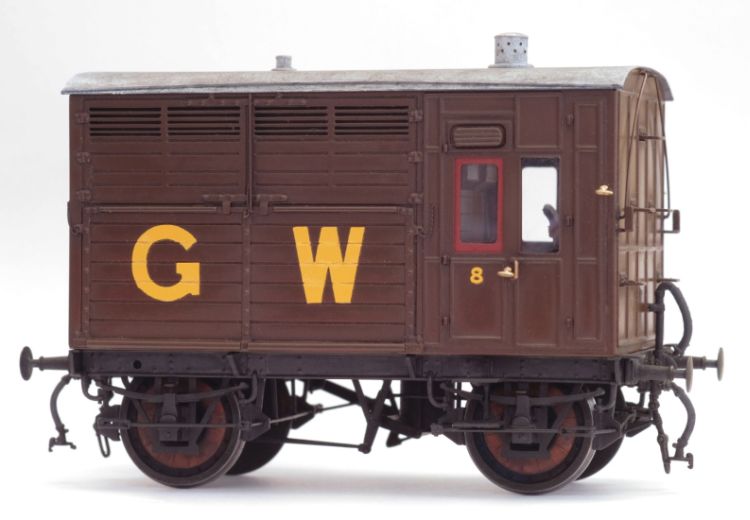 |
| Diagram N10 horse box c 1920, with 25" lettering, and thought to be in unlined crimson lake livery | 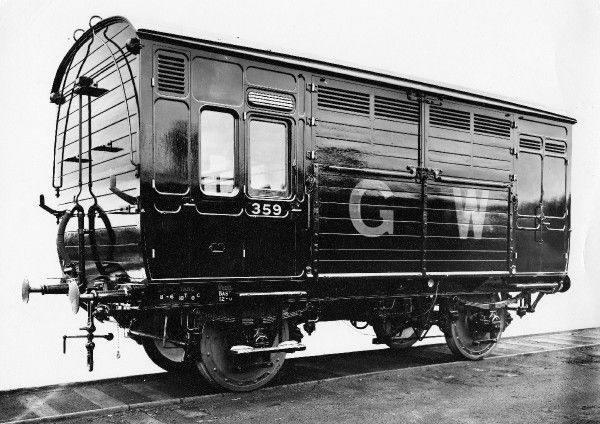 |
Some GWR stock designed to run with passenger trains or at express speeds was classed as 'Non-passenger-carrying coaching stock' (NPCCS). They are commonly called 'brown vehicles', reflecting their livery, although this is somewhat of a misnomer, since not all types of NPCCS were always brown. The diagrams for these vehicles were in the passenger diagram series. The vehicles covered a variety of types: horse boxes, carriage trucks, fish trucks, milk vans ('Siphons'), fish vans, 'special' cattle wagons and some fruit vans.
Up to 1912, the body colour used for NPCCS was brown. This colour was the same as that used on coaching stock. Between 1912 and 1920 the situation becomes more complex, with some NPCCS receiving passenger stock crimson lake livery, the only difference from the passenger livery being that the ends were also in lake. It is thought the only types actually receiving the crimson lake livery were horse boxes (including of course new build stock after 1912), and possibly carriage trucks – less likely are the fish vehicles (Bloaters and Tadpoles) and special cattle wagons (Beetles). There is no evidence of Siphons appearing in crimson lake. Some horse boxes and carriage trucks were lined, but it is not clear how widespread this was, and lining seems to have ceased to be applied to these vehicles during WWI.
The other complicating factor in the 1912–1920 period was the c 1915 reclassification and renumbering of some fish and fruit freight vehicles into the passenger stock lists. The reclassification, primarily a Paddington accountancy dodge, did not lead to all its implications being observed by the paint shops at Swindon, especially during the economic and resource climate of World War I – as with any stock, vehicles were not called in for a full repaint if their condition did not warrant it. The output of Swindon's coach shops, in both construction and repainting terms, was minimal during WWI, many of the staff having gone to the war or employed on more pressing war production, and there seems to be no evidence of the transferred vehicles being renumbered, let alone reliveried, at the time of their transfer. It is likely that repainting of the transferred vehicles did not commence until some time after the war, and the longer Y3 diagram Fruits were being painted in brown by 1920. Jack Slinn's Great Western Way (HMRS) is perhaps a little contradictory over the question of the 'brown vehicles' receiving crimson lake, and discusses the question at some length, but concludes there is considerable doubt whether more than a small minority of these reclassified vehicles actually received the official passenger livery of the day. An example of a Y2 fruit van transition from grey to brown livery is given in Fruit Van 47886/2356.

Outside-framed Siphon G diagram O11 restored at the Severn Valley Railway to its original livery, with brown ends. The ironwork on the ends (steps, lamp brackets and handrails) is black. 16" lettering. Click on the image for a bigger version. Image courtesy of Gareth Price.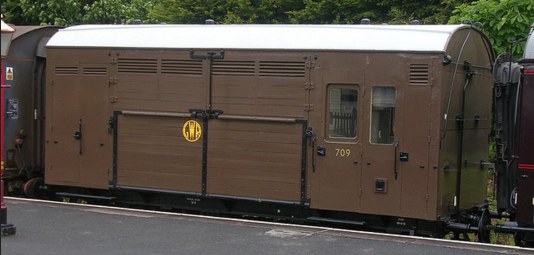
Diagram N16 Horsebox, on the Gloucester Warwickshire Railway, with a roundel, and black ironwork for the horse doors. The ends should possibly be black for these 1937-built vehicles. Click on the image for a bigger version. Image courtesy of Gareth Price.
Ends of horse boxes were brown (pre-1912), crimson lake (in the early crimson lake era), brown from c 1920, and then black (to be consistent with normal coaching stock livery practice). The date when the horse box ends changed from brown to black is unknown, possibly mid- to late-1930s, although there is some doubt about whether this change was applied on a consistent basis. Ends of siphons however, both bogie and 6-wheel, seem to have remained in brown throughout their GWR lives.
Special cattle wagons (code 'Beetle') diagrams W4 and W7, which had been painted grey when built, were reclassified into the passenger stock lists in 1927, and painted brown, with black ends. Subsequent special cattle wagon diagrams W13 and W14 were built after 1927, and were always numbered in the passenger stock lists and painted the same.
Determination of livery from prototype black and white photographs is often difficult because NPCCS vehicles, with the exception of horse boxes, were rarely cleaned, and were expected to go between 10 and 12 years before repainting.
For the sizes of letters, the vehicles followed the general changes used on ordinary freight stock, with 25" letters introduced from c 1904, replaced in 1920 with the 16" letters. The 25" lettering however was used only where space permitted – outside-framed Siphons are one such case where the actual size of the G W appears to have been about 16". On horse boxes and 6-wheel siphons, G W did not appear on the ends, but on 4-wheel siphons, bogies siphons and carriage trucks did appear on the ends. An interesting case illustrating the use of different sized lettering is the Siphon C which was produced with 25" letters on the ends but 16" letters on the sides. NPCCS lettering was yellow.
The hinges and strapping for the horse doors on horseboxes appear to have been black prior to 1912, were bodywork crimson until 1922, and thereafter at an unknown date (possibly early 1930s) re-appeared in black.
On NPCCS, solebars, headstocks, running gear and any footboards were black. Buffers on NPCCS were 2', round-head.
Some vehicles also carried the appropriate telegraphic codes, written in block letters at the center of the sides. Special instructions, such as "For Fish Traffic Only" were in italics. Some 6-wheel siphons, some fruit vans and some horse boxes were fitted with Westinghouse brake gear, for interworking with other companies, and were marked 'Westinghouse Fitted' on the ends. The Westinghouse brake gear is thought to have been removed by c 1931.
1934 saw the GWR roundel introduced, which generally suited this type of vehicle better than it did the passenger coaches. The small yellow letters were the same size (5") used on the post-1936 ordinary goods stock. 'XP' markings began to appear in 1938. (The official notice of the XP marking was issued on 30 September 1938.)
| Fruit C diagram Y9 2815, built in 1937. These were the last vehicles to feature DCIII brakes. Image link courtesy Commons Creative Licence |
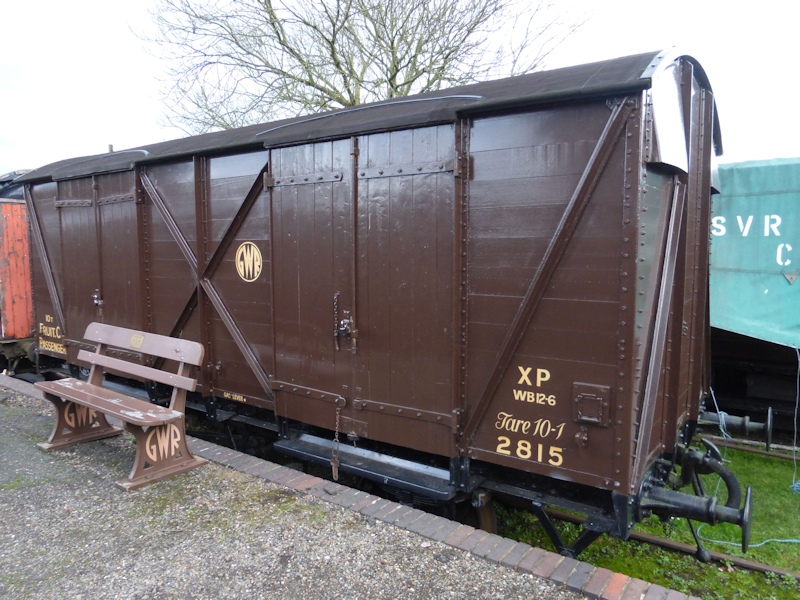 |
BR(W) continued painting some vehicles brown for a few years after nationalisation; thereafter, any surviving NPCCS vehicles being repainted appeared in unlined crimson or (from 1957) maroon. The ends of diagram O62 siphons were originally black, although it seems many other siphons continued with body-colour ends, and other NPCCS had black ends from 1957. From 1964/5, with the introduction of spray painting, ends were in body colour. Some bogie siphons and Fruit Ds lasted into the BR blue era.

WEP Models 7mm diagram W7 special cattle wagon in faded BR crimson livery (with black ends), built by, and picture courtesy of, Tony Geary.
| Section Page | Previous Page | Next Page |
